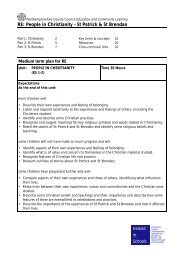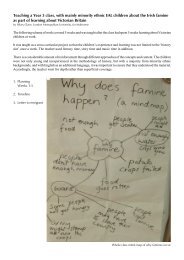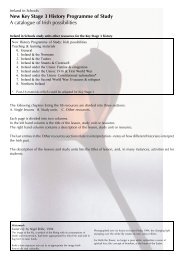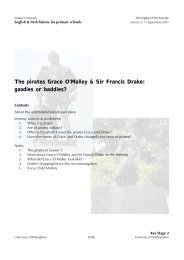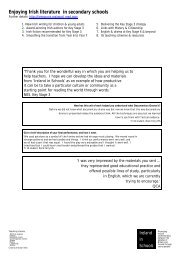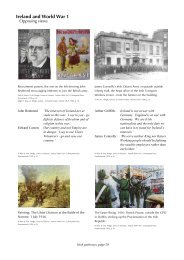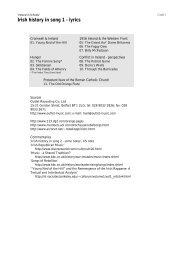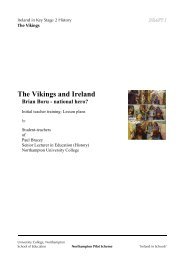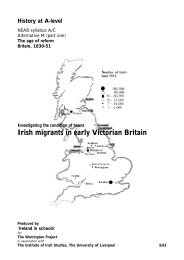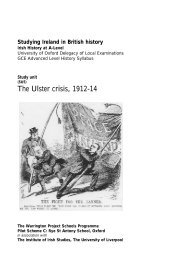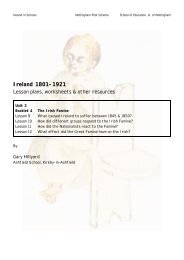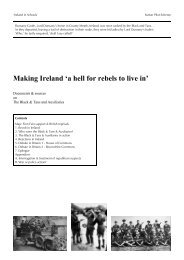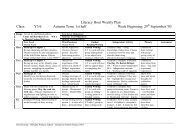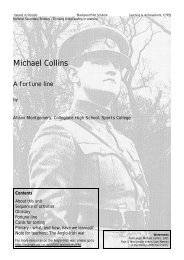E:\WP Literature & Literacy units 2 - WP\L217PS ... - Ireland in Schools
E:\WP Literature & Literacy units 2 - WP\L217PS ... - Ireland in Schools
E:\WP Literature & Literacy units 2 - WP\L217PS ... - Ireland in Schools
Create successful ePaper yourself
Turn your PDF publications into a flip-book with our unique Google optimized e-Paper software.
’<strong>Ireland</strong> <strong>in</strong> <strong>Schools</strong> Deliver<strong>in</strong>g the NLS through <strong>Ireland</strong> QLS, Staffordshire<br />
Year 5 Scheme of Work<br />
<strong>Literacy</strong> Hour & Beyond<br />
’Irish literature has created a magical learn<strong>in</strong>g environment for our children, its<br />
range and quality enabl<strong>in</strong>g all of them to participate <strong>in</strong> our <strong>Ireland</strong> project and to<br />
produce work of fantastic quality.<br />
Barbara Heath & Jo Rob<strong>in</strong>son<br />
Gorsemoor Primary School
Contents<br />
Gorsemoor‘s <strong>Ireland</strong> project 1<br />
1. The text 2<br />
2. The author 3<br />
3. Lesson plans 4<br />
4. Sample worksheets from the Film and Study Guide 8<br />
5. L<strong>in</strong>ks 18<br />
6. Children‘s work 1<br />
(Gorsemoor Primary School) 19<br />
7. Children‘s work 2<br />
(St Joseph‘s RC Primary School, Penketh) 24<br />
Appendices<br />
A. Under the Hawthorn Tree from Real Books for Primary <strong>Schools</strong> 28<br />
B. áGather<strong>in</strong>g Nuts‘ - an Irish verse 29<br />
C. Historical note on the fam<strong>in</strong>e <strong>in</strong> <strong>Ireland</strong> 30
Gorsemoor s <strong>Ireland</strong> project<br />
Gorsemoor Primary School lies on a large new hous<strong>in</strong>g estate on the outskirts of Cannock <strong>in</strong> Staffordshire. A 5-11 school<br />
with an Early Years unit, it has 430 pupils on roll. For two years the school has made a special study of the island of <strong>Ireland</strong><br />
<strong>in</strong> Years 5 and 6, particularly by us<strong>in</strong>g Irish texts <strong>in</strong> the <strong>Literacy</strong> Hour. The school re-<strong>in</strong>forces this learn<strong>in</strong>g experience with<br />
visits by Irish authors and by forg<strong>in</strong>g l<strong>in</strong>ks with children <strong>in</strong> a primary school <strong>in</strong> Belfast and another <strong>in</strong> County Dubl<strong>in</strong>.<br />
Involv<strong>in</strong>g all children<br />
In Years 5 and 6 there are some very gifted children, but there is also a significant m<strong>in</strong>ority of children on the Special<br />
Education Needs register - 18 <strong>in</strong> the current school year (2001-2), of whom 15 are boys. The range and quality of Irish<br />
children‘s literature suits such a mix of children, allow<strong>in</strong>g all the children to participate <strong>in</strong> a common project. They can all<br />
enjoy read<strong>in</strong>g books which are suited to their <strong>in</strong>dividual <strong>in</strong>terests and abilities.<br />
Teach<strong>in</strong>g schemes<br />
For the texts used, Gorsemoor has produced teach<strong>in</strong>g schemes, which generally conta<strong>in</strong> NLS weekly plann<strong>in</strong>g sheets,<br />
examples of worksheets etc., and samples of children‘s work. The schemes are reproduced <strong>in</strong> pdf format <strong>in</strong> the ’<strong>Ireland</strong> <strong>in</strong> <strong>Schools</strong>ó<br />
CD-ROM, No. 01. The location of each scheme on the CD-ROM is given <strong>in</strong> italics.<br />
Sett<strong>in</strong>g the scene<br />
Children are <strong>in</strong>troduced to the island of <strong>Ireland</strong> through cross-curricular activity sheets (IiS CD-Rom 01 <strong>in</strong> the History &<br />
citizenship directory: C208 <strong>Ireland</strong> Activity Sheets).<br />
Historical fiction - Under the Hawthorn Tree<br />
The favourite novel is an historical one - Under the Hawthorn Tree by Marita Conlon-McKenna (O‘Brien Press, O-86278-<br />
206-6), the first of an award-w<strong>in</strong>n<strong>in</strong>g trilogy, with excit<strong>in</strong>g cross-curricular potential (IiS CD-Rom 01 <strong>in</strong> the <strong>Literature</strong> & literacy<br />
directory: L217 Under the Hawthorn Tree - Fam<strong>in</strong>e Story). A Channel 4 film of the book assists the less able and reluctant<br />
readers, as does the existence of excellent easy readers on the fam<strong>in</strong>e (such as The Great Hunger by Malachy Doyle,<br />
Frankl<strong>in</strong> Watts, 0-74963-447-2, and Fam<strong>in</strong>e by Arthur McKeown, Poolbeg, 1-85371-505-0).<br />
Other texts used<br />
Among Irish myths, legends and fairy tales, the one which most captures the children‘s imag<strong>in</strong>ation is áThe Sea Woman‘<br />
as retold by Sionbhe Lally <strong>in</strong> the lavishly illustrated Favourite Irish Fairy Tales Poolbeg Press, 1-85371-777-0 (IiS CD-Rom<br />
01 <strong>in</strong> the New trials directory: NL224 Sea Woman - Gorsemoor. For the cross-curricular aspects, see ’Human Be<strong>in</strong>gs under a Spelló<br />
on the IiS CD-Rom 01 <strong>in</strong> the <strong>Literature</strong> & literacy directory: L219).<br />
Reluctant readers among the boys have responded well to fast-mov<strong>in</strong>g fantasies by Irish authors, such as The Battle below<br />
Giltspur by Cormac MacRaois, Wolfhound Press, 0-86327-356-4 (IiS CD-Rom 01 <strong>in</strong> the <strong>Literature</strong> & literacy directory: L211<br />
and L216), and Cirque du Freak, by Darren Shan, Harper Coll<strong>in</strong>s, 0-00675-416-3 (IiS CD-Rom 01<strong>in</strong> the New trials directory:<br />
NL221 Cirque du Freak).<br />
It rema<strong>in</strong>s to be seen how the children respond to the reality of urban life <strong>in</strong> contemporary <strong>Ireland</strong> when they beg<strong>in</strong> read<strong>in</strong>g<br />
The Moon K<strong>in</strong>g by Siobhan Park<strong>in</strong>son, (O‘Brien Press, O-86278-573-1).<br />
SEN<br />
Books like The Lough Neagh Monster (IiS CD-Rom 01 <strong>in</strong> the New trials directory: NL223 Irish & Other Monsters) enable the<br />
children with special education needs to play a full part <strong>in</strong> the <strong>Ireland</strong> project. Such stories provide high <strong>in</strong>terest material<br />
at a low read<strong>in</strong>g age while at the same time offer<strong>in</strong>g opportunities to address key grammatical features and extend spoken<br />
vocabulary.<br />
Another favourite with this group is the tale of the two giants, the outwitt<strong>in</strong>g of Cucull<strong>in</strong> by F<strong>in</strong>n MacCoul and his fearless<br />
wife (IiS CD-Rom 01 <strong>in</strong> the New trials directory: NL222 Giantsó Week). The group will shortly read two books by Siobhan<br />
Park<strong>in</strong>son, an author who is fast becom<strong>in</strong>g a favourite <strong>in</strong> Years 5 and 6: The Leprechaun Who Wished He Wasnót (O‘Brien<br />
Press, 0-86278-334-8) and Cows Are Vegetarians, the misadventures of a Dubl<strong>in</strong> girl visit<strong>in</strong>g her cous<strong>in</strong>s <strong>in</strong> the country<br />
(O‘Brien Press, 0-86278-694-0).<br />
Heath & Rob<strong>in</strong>son, Hawthorn Tree, page 1
1. The text<br />
Under the Hawthorn Tree by Marita Conlon-McKenna (O‘Brien Press, ISBN O-86278-206-6) is the first of an<br />
award-w<strong>in</strong>n<strong>in</strong>g trilogy, a gripp<strong>in</strong>g story of love, loyalty and courage set <strong>in</strong> the time when <strong>Ireland</strong> was devastated<br />
by the Great Fam<strong>in</strong>e of the 1840s. Three children, Eily, Michael and Peggy, are left to fend for themselves.<br />
Starv<strong>in</strong>g and <strong>in</strong> danger of the dreaded workhouse, they escape <strong>in</strong> the hope of f<strong>in</strong>d<strong>in</strong>g the great-aunts they have<br />
heard about <strong>in</strong> their mother‘s stories. With tremendous courage they set out on a journey that will test every<br />
reserve of strength, love and loyalty they possess.<br />
The other two parts of the Fam<strong>in</strong>e trilogy are:<br />
Wildflower Girl (O‘Brien Press, ISBN O-86278-283-X) tells the story of Peggy who emigrates to America after<br />
the fam<strong>in</strong>e.<br />
Fields of Home (O‘Brien Press, ISBN O-86278-509-X) traces the lives of Eily, Michael and Peggy <strong>in</strong>to<br />
adulthood. In America Peggy hears the call of the wild west. In <strong>Ireland</strong> Eily and her family struggle to make<br />
a liv<strong>in</strong>g on a small farm and Michael works <strong>in</strong> the Big House and loses his job because the house is burned down<br />
and the landlord‘s family leave <strong>Ireland</strong> forever. A poor evicted widow‘s hovel is raised to the ground, and she<br />
walks away with dignity to the workhouse. áIn both cases tragedy is confronted with pride. Survival is still<br />
difficult, but now there is the comfort of food - floury potatoes, butter, milk, boiled beef, and jams and tarts.‘<br />
Study guides<br />
The publisher, O‘Brien Press, has produced two guides to Under the Hawthorne Tree to meet the requirements<br />
of the new Irish curriculum: Real Books for Primary <strong>Schools</strong> (ISBN 0-86278-609-6), p. 39, provides outl<strong>in</strong>e<br />
guidance (see Appendix A). Teach<strong>in</strong>g Guides Collection 2 (ISBN 0-86278-666-5), pp 5-8, offers a detailed<br />
scheme of study. The guides can be readily adapted to the curriculum <strong>in</strong> England and Wales.<br />
A film on video and a study guide to the film (and novel) are also available: Channel 4, Under the Hawthorn<br />
Tree - The Great Irish Fam<strong>in</strong>e (film), ISBN O‘Brien Press, 0-86215-496-1; and I. Barber, Under the Hawthorn<br />
Tree - The Great Irish Fam<strong>in</strong>e. A Study Guide to the Novel and the Film, O‘Brien Press, ISBN 0-86278-583-9.<br />
Other fam<strong>in</strong>e books<br />
The Long March by Marie-Louise Fitzpatrick (Wolfhound Press, ISBN 0-86327-644-X) is <strong>in</strong>spired by the<br />
generosity of the Choctaw Indians who <strong>in</strong> 1847 raised 170 dollars for fam<strong>in</strong>e relief <strong>in</strong> <strong>Ireland</strong>. This superbly<br />
illustrated book tells the mov<strong>in</strong>g story of that tribe‘s own dispossession and enforced exile. Young Choona<br />
struggles to understand why his people would care about white men dy<strong>in</strong>g on the other side of the world, as he<br />
learns the history of the Choctaw‘s tragic Long March to freedom and appreciates the historical similarities<br />
between the two peoples, <strong>in</strong>clud<strong>in</strong>g great respect for the land, dispossession and potato eat<strong>in</strong>g.<br />
The Great Hunger by Malachy Doyle (Frankl<strong>in</strong> Watts, 0-74963-447-2) is an áeasy reader‘ tell<strong>in</strong>g how Art and<br />
his sister Maggie leave home when the potato crop fails and the landlord demands the rent and they go to Belfast<br />
and then to Liverpool <strong>in</strong> search of their father who is look<strong>in</strong>g for work.<br />
Fam<strong>in</strong>e by Arthur McKeown (Poolbeg Press, ISBN 1-85371-505-0) is another áeasy reader‘ show<strong>in</strong>g how Joe<br />
and his daughter Maggie were forced to leave the family farm <strong>in</strong> the North of <strong>Ireland</strong> and emigrate to America,<br />
via Belfast.<br />
The Hungry W<strong>in</strong>d by So<strong>in</strong>bhe Lally (Poolbeg Press, ISBN 1-85371-717-7) is a starkly realistic account of the<br />
impact and consequences of the fam<strong>in</strong>e on the family of Maeve and Breege from workhouse to Australia.<br />
Despite the grief, it is a story of hope and survival of the human spirit and is more suitable for older children.<br />
Heath & Rob<strong>in</strong>son, Hawthorn Tree, page 2
2. The author<br />
Marita Conlon-McKenna is <strong>Ireland</strong>‘s bestsell<strong>in</strong>g children‘s author. Born <strong>in</strong> Dubl<strong>in</strong><br />
<strong>in</strong> 1956 and brought up <strong>in</strong> Goatstown, Marita went to school at the Convent of the<br />
Sacred Heart, Mount Anville, later work<strong>in</strong>g <strong>in</strong> the family bus<strong>in</strong>ess, the bank, and a<br />
travel agency. In 1977 she married James McKenna and they have four children,<br />
Amanda, Laura, Fiona and James. They live <strong>in</strong> the Stillorgan area of Dubl<strong>in</strong>. Marita<br />
writes for all ages - from very young children (Granny McG<strong>in</strong>ty) to adults (The<br />
Magdalen). Her subjects range from the whimsical to the socially contentious.<br />
Marita was always fasc<strong>in</strong>ated by the Fam<strong>in</strong>e period <strong>in</strong> Irish history and read<br />
everyth<strong>in</strong>g available on the subject. When she heard a radio report of an unmarked children‘s grave from the<br />
Fam<strong>in</strong>e period be<strong>in</strong>g found under a hawthorn tree, she decided to write her first book, Under the Hawthorn Tree,<br />
Children of the Fam<strong>in</strong>e. An immediate best-seller, it rema<strong>in</strong>ed <strong>in</strong> the best-seller lists for two years. It has also<br />
been filmed for RTE and Channel 4, and is available on video. The publisher did not th<strong>in</strong>k it would sell.<br />
Marita has been showered with awards. Under the Hawthorn Tree won the International Read<strong>in</strong>g Association<br />
Award <strong>in</strong> 1991, the first time this prestigious award went to <strong>Ireland</strong>, the Read<strong>in</strong>g Association of <strong>Ireland</strong> Top<br />
Award, and Osterreichischer K<strong>in</strong>der and Jugendbuchpreis, Austria, <strong>in</strong> 1993. In 1993 The Blue Horse (1991),<br />
the story of a travell<strong>in</strong>g family, won the Bisto Book of the Year Award. No Goodbye, Marita‘s fourth novel<br />
(1994), tells of the heartbreak of a young family when their mother leaves home and is recommended by Book<br />
Trust <strong>in</strong> their guide for One Parent Families.<br />
It was Marita‘s ambition to be an author ’ever s<strong>in</strong>ce I was very, very small ... even as young as five or six, I<br />
wanted to write and <strong>in</strong> particular, to write for children. When I tell that to children I meet <strong>in</strong> schools they canót<br />
believe that but it was a th<strong>in</strong>g I wanted very muchó. Marita‘s books are published throughout the world. ’I get<br />
a big thrill when I see the foreign covers, some of which I like, some not so much. Foreign publishers often<br />
th<strong>in</strong>k that every child <strong>in</strong> <strong>Ireland</strong> has red hair and freckles. The American covers are beautiful, a bit like Little<br />
House on the Prairie.ó<br />
Heath & Rob<strong>in</strong>son, Hawthorn Tree, page 3
3. Lesson plans<br />
Heath & Rob<strong>in</strong>son, Hawthorn Tree, page 4
NATIONAL LITERACY KS2 PLANNING SHEET<br />
Class: Year 5 Text used: Under the Hawthorn Tree<br />
by Marita Conlon-McKenna<br />
<strong>in</strong> conjunction with the video film and study guide<br />
SPELLING PATTERNS<br />
TOP:<br />
MIDDLE:<br />
BOTTOM:<br />
See spell<strong>in</strong>g<br />
folder<br />
Homework:<br />
Week: 1 Range:<br />
* <strong>in</strong>dicates opportunities for Speak<strong>in</strong>g and Listen<strong>in</strong>g<br />
The top and middle literacy sets read the book dur<strong>in</strong>g group read<strong>in</strong>g. The lower set read The Great Hunger by Malachy Doyle, the Sparks series.<br />
’ To re-read parts of the book as<br />
appropriate<br />
WK LEARNING OBJECTIVES WHOLE CLASS<br />
SHARED TEXT WORK<br />
WHOLE CLASS<br />
WORD/SENTC WORK<br />
INDEPENDENT WORK<br />
GUIDES GROUP<br />
READING/WRITING (Y3/4)<br />
PLENARY (Y5/6)<br />
M<br />
ó To consolidate a basic element of<br />
standard English (adjectives) (S2)<br />
ó Characters presented (T3)<br />
ó To make notes on the characters to<br />
enable the children to use this<br />
knowledge <strong>in</strong> the next lessons<br />
(T14)<br />
ó To watch the programme áThe<br />
Great Hunger‘ on video<br />
ó To recap on who the characters are<br />
- Margaret, John, Bridget, Eily,<br />
Michael and Peggy<br />
ó To discuss briefly potato fam<strong>in</strong>e<br />
ó Adjectives. To revise what<br />
adjectives are<br />
ó To choose a person <strong>in</strong> the room,<br />
us<strong>in</strong>g adjectives to describe what<br />
that person is like<br />
*<br />
ó Character sketch sheet, us<strong>in</strong>g<br />
previous knowledge on adjectives<br />
to describe the characters of Eily,<br />
Michael and Peggy. This is a form<br />
of note tak<strong>in</strong>g for future reference<br />
ó Children to share their adjectives<br />
with the class so that we have an<br />
overall op<strong>in</strong>ion/view of the 3<br />
characters<br />
*<br />
T<br />
ó To use the note mak<strong>in</strong>g skill, and<br />
know what á<strong>in</strong> your own words‘<br />
means (T20)<br />
ó To know what empathy means and<br />
to th<strong>in</strong>k from the viewpo<strong>in</strong>t of a<br />
character<br />
ó To summarise programme áThe<br />
Great Hunger‘ <strong>in</strong> own words.<br />
Upper/Middle written; lower orally<br />
ó To identify ma<strong>in</strong> concepts:<br />
fam<strong>in</strong>e, blight, illness, sense of<br />
loss poverty<br />
ó To discuss what the ma<strong>in</strong> concepts<br />
mean and why the fam<strong>in</strong>e<br />
happened (teacher <strong>in</strong>put on the<br />
History element of the Irish potato<br />
fam<strong>in</strong>e)<br />
ó The death of Bridget, how would<br />
they feel: Circle time on empathy<br />
of loss<br />
ó Children to complete the<br />
worksheet on May 1846, áThe day<br />
we buried Bridget‘<br />
ó Lower group to have more groupbased<br />
discussion for record<strong>in</strong>g<br />
ó To discuss that the death of a loved<br />
one is sad and that the feel<strong>in</strong>gs we<br />
have are normal follow<strong>in</strong>g a loss.<br />
Children to share emotions of<br />
personal loss or the characters‘ loss<br />
*<br />
W<br />
ó To write/perform poems <strong>in</strong> a<br />
different way - writ<strong>in</strong>g a prayer for<br />
Bridget (T5)<br />
ó To edit their work (T22)<br />
ó To read pages 21-25 of the novel<br />
*<br />
ó To compare how the children<br />
would have felt (sheets on<br />
emotions <strong>in</strong> the novel. The<br />
atmosphere <strong>in</strong> class will probably<br />
be sad. Expla<strong>in</strong> that <strong>in</strong> a time of<br />
sadness we pray (a form of poetry)<br />
ó Children to draft a prayer for<br />
Bridget. Use to make comparison<br />
with a poem/celebration of<br />
life/what would you want to say at<br />
the moment of goodbye<br />
ó Children to edit/evaluate their<br />
work <strong>in</strong> draft and complete a f<strong>in</strong>al<br />
version<br />
T<br />
ó To <strong>in</strong>vestigate different versions of<br />
the same story <strong>in</strong> pr<strong>in</strong>t or film and<br />
identify similarities and<br />
differences (T2)<br />
ó To compare the novel to the film so far. Ask the children which they th<strong>in</strong>k<br />
is better/bra<strong>in</strong>storm the qualities for/aga<strong>in</strong>st the novel/film with specific<br />
reference to Bridget‘s death<br />
ó Children to write out their f<strong>in</strong>al<br />
prayer<br />
ó To perform the read<strong>in</strong>g of the<br />
prayers to the rest of the class<br />
*<br />
F<br />
We do extended writ<strong>in</strong>g once a week/<strong>Literacy</strong> lesson 4 times a week. We are also work<strong>in</strong>g <strong>in</strong> our Irish study books for PHSE.<br />
Extended writ<strong>in</strong>g:<br />
A diary account from one of the children‘s viewpo<strong>in</strong>t. Today I feel/did etc.<br />
In Art, make a photograph frame for a character and mount the picture <strong>in</strong> the frame<br />
’<strong>Ireland</strong> <strong>in</strong> <strong>Schools</strong> Staffordshire Pilot Scheme Gorsemoor PS<br />
Heath & Rob<strong>in</strong>son, Hawthorn Tree, page 5
NATIONAL LITERACY KS2 PLANNING SHEET<br />
Class: Year 5 Text used: Under the Hawthorn Tree<br />
by Marita Conlon-McKenna<br />
Week: 2 Range:<br />
* <strong>in</strong>dicates opportunities for Speak<strong>in</strong>g and Listen<strong>in</strong>g<br />
SPELLING PATTERNS<br />
TOP: See spell<strong>in</strong>g<br />
MIDDLE: folder<br />
BOTTOM:<br />
Homework:<br />
’ Children to try and learn their<br />
parts<br />
WK LEARNING OBJECTIVES WHOLE CLASS<br />
SHARED TEXT WORK<br />
WHOLE CLASS<br />
WORD/SENTC WORK<br />
INDEPENDENT WORK<br />
GUIDES GROUP<br />
READING/WRITING (Y3/4)<br />
PLENARY (Y5/6)<br />
M<br />
ó To have empathy for children of<br />
their age and real life history<br />
ó To <strong>in</strong>vestigate how characters are<br />
presented (T3)<br />
ó To watch the programme áOn<br />
Their Own‘ on video<br />
ó To discuss the fact that people are<br />
starv<strong>in</strong>g and the effects on<br />
people‘s lives<br />
ó Read parts of ch. 3 of the novel<br />
áNoth<strong>in</strong>g to Eat‘ as appropriate<br />
ó Talk about the roadworks and why<br />
John is still away<br />
ó Circle time on how the children<br />
would feel to be left áHome<br />
Alone‘. Talk about the Home<br />
Alone sheet with the<br />
children/Complete *<br />
ó Talk through the answers.<br />
Emphasis on áwhy‘/personal<br />
op<strong>in</strong>ions/how are the characters<br />
portrayed<br />
*<br />
T ó Characters presented through<br />
dialogue (T3)<br />
ó Talk about old language and the<br />
fact that languages have died out<br />
<strong>in</strong> Brita<strong>in</strong><br />
ó Language used portrays characters<br />
ó Introduce the fact that we use<br />
terms of affection when talk<strong>in</strong>g to<br />
children - Irish words<br />
a stor - darl<strong>in</strong>g;<br />
a ghile - beloved<br />
ó Talk through how they are<br />
pronounced<br />
ó Bra<strong>in</strong>storm terms of endearment<br />
today as a class<br />
ó Record them on the wall of<br />
endearment<br />
*<br />
ó Children will have ámade up‘<br />
words of endearment. Opportunity<br />
to share them<br />
*<br />
W<br />
T<br />
ó áTo be <strong>in</strong> the role of characters, to<br />
convey feel<strong>in</strong>gs, reflections,<br />
moods through drama (T16)<br />
ó To write own playscripts (T18)<br />
ó To annotate a section of a<br />
playscript as a preparation for<br />
performance, tak<strong>in</strong>g <strong>in</strong>to account<br />
pace, movement, gesture and<br />
delivery of l<strong>in</strong>es (T19)<br />
ó To evaluate performance (T20)<br />
ó To look at the playscript. Read<br />
through it and discuss the learn<strong>in</strong>g<br />
objective elements<br />
ó Discuss action, audience/role to<br />
ensure children can present the<br />
play<br />
The children will be work<strong>in</strong>g <strong>in</strong> small groups of 3 to read/practise/perform the<br />
drama. They must get <strong>in</strong>to character role. *<br />
The aim is to perform to the whole class by Thursday. *<br />
On the performance day, children to wear costumes etc. (Take digital<br />
photographs).<br />
At the end of session children will have the opportunity to go on a walk to<br />
conservation area/around school<br />
ó For the plenary we will watch the<br />
drama. We will evaluate the<br />
performance and how the children<br />
portrayed the characters well or<br />
how they could improve. *<br />
ó Perform <strong>in</strong> assembly<br />
F<br />
We will cont<strong>in</strong>ue to work <strong>in</strong> our Irish study books for PHSE.<br />
Extended writ<strong>in</strong>g:<br />
Cont<strong>in</strong>ue with diary writ<strong>in</strong>g. Use extended writ<strong>in</strong>g time to ensure the week‘s work is complete and we have filled <strong>in</strong> all that is necessary.<br />
Heath & Rob<strong>in</strong>son, Hawthorn Tree, page 6
NATIONAL LITERACY KS2 PLANNING SHEET<br />
Class: Year 5 Text used: Under the Hawthorn Tree<br />
by Marita Conlon-McKenna<br />
Week: 3 Range:<br />
* <strong>in</strong>dicates opportunities for Speak<strong>in</strong>g and Listen<strong>in</strong>g<br />
SPELLING PATTERNS<br />
TOP: See spell<strong>in</strong>g<br />
MIDDLE: folder<br />
BOTTOM:<br />
Homework:<br />
’ Children to watch the news (are<br />
any people starv<strong>in</strong>g <strong>in</strong> the world<br />
today? If so, why?)<br />
’ Complete work <strong>in</strong> study books<br />
WK LEARNING OBJECTIVES WHOLE CLASS<br />
SHARED TEXT WORK<br />
WHOLE CLASS<br />
WORD/SENTC WORK<br />
INDEPENDENT WORK<br />
GUIDES GROUP<br />
READING/WRITING (Y3/4)<br />
PLENARY (Y5/6)<br />
M<br />
ó To use knowledge ga<strong>in</strong>ed to<br />
establish áneed‘ rather than áwould<br />
like‘<br />
ó To watch the programme áThe<br />
Journey‘ on video<br />
ó Talk about the programme and two<br />
key concepts<br />
workhouse, history of <strong>Ireland</strong><br />
ó Read pages 62-3 and discuss the<br />
advice Mary Kate gave to the<br />
children.<br />
ó Talk about herbal remedies<br />
*<br />
ó Imag<strong>in</strong>e that you are go<strong>in</strong>g on a<br />
journey<br />
a. What advice might your mum<br />
give you if you were go<strong>in</strong>g on<br />
a journey?<br />
b. What would you take with you<br />
if you were go<strong>in</strong>g on a<br />
journey? *<br />
ó Talk through children‘s list but<br />
emphasis is on why you would<br />
take it<br />
*<br />
T ó To summarise the book/video -<br />
How do the children th<strong>in</strong>k it will<br />
conclude? What do they know?<br />
What do they need to f<strong>in</strong>d out?<br />
(compar<strong>in</strong>g the novel and film)<br />
(T2)<br />
ó Recall ma<strong>in</strong> events <strong>in</strong> the film on<br />
video so far (<strong>in</strong> preparation for<br />
f<strong>in</strong>al programme)<br />
ó Compare film to book. Which do<br />
children prefer?<br />
ó Share the unusual cures<br />
<strong>in</strong>formation (children f<strong>in</strong>d this<br />
<strong>in</strong>terest<strong>in</strong>g)<br />
*<br />
ó Children to make up their own<br />
cures for modern illnesses and<br />
write them out<br />
ó Children read out their cures to the<br />
class<br />
*<br />
W<br />
ó To conclude the video and<br />
complete a conclusion on the<br />
children‘s journey<br />
ó To watch the programme áThe<br />
Search‘ on video<br />
ó Discuss video - soup kitchen, dead<br />
man (why is he dead?)<br />
ó How must the children feel? -<br />
bleed<strong>in</strong>g the cow, the struggle,<br />
meet<strong>in</strong>g aunts<br />
ó Why the Irish disliked the English<br />
(soldier <strong>in</strong>cident)<br />
*<br />
ó Cover designs. Children to<br />
complete the worksheet activity<br />
ó To compare each others‘ designs<br />
T<br />
F<br />
ó We will use this session to complete any work, to discuss the book and film and lives of the ma<strong>in</strong> characters and distribute and evaluate our work.<br />
ó To prepare our work for display at the dissem<strong>in</strong>at<strong>in</strong>g good practice conference at the K<strong>in</strong>gston Centre <strong>in</strong> Stafford.<br />
We will cont<strong>in</strong>ue to work <strong>in</strong> our Irish study books for PHSE.<br />
Extended writ<strong>in</strong>g:<br />
Cont<strong>in</strong>ue with diary writ<strong>in</strong>g.<br />
Heath & Rob<strong>in</strong>son, Hawthorn Tree, page 7
4. Sample worksheets<br />
from<br />
Under the Hawthorn Tree - The Great Irish Fam<strong>in</strong>e. A Study Guide to the Novel and the Film,<br />
by I. Barber, O Brien Press, ISBN 0-86278-583-9<br />
This guide is arranged around the four episodes of the film:<br />
1 Hunger<br />
2 On their own<br />
3 The journey<br />
4 The search<br />
There are 26 worksheets - those marked * are reproduced <strong>in</strong> the follow<strong>in</strong>g pages:<br />
1. Character sketches*<br />
2. Beg<strong>in</strong>n<strong>in</strong>gs<br />
3. Everyday life <strong>in</strong> <strong>Ireland</strong> <strong>in</strong> the 1840s<br />
4. Hous<strong>in</strong>g for rich and poor<br />
5. Crop failure, hunger and fam<strong>in</strong>e<br />
6. Disease and death<br />
7. The hawthorn tree <strong>in</strong> folklore<br />
8. Home alone* and follies<br />
9. Lost languages<br />
10. Say<strong>in</strong>g goodbye<br />
11. Before and after the fam<strong>in</strong>e<br />
12. Public relief works 1846<br />
13. The family tree<br />
14. Starvation<br />
15. Workhouses<br />
16. Newry workhouse<br />
17. Folk medic<strong>in</strong>e*<br />
18. Landlords<br />
19. Cover design*<br />
20. Boys‘ work and girls‘ work<br />
21. Soup kitchens<br />
22. Death<br />
23. Fam<strong>in</strong>e <strong>in</strong> the Sudan, 1998<br />
24. Fam<strong>in</strong>e song<br />
25. End<strong>in</strong>gs<br />
26. Fam<strong>in</strong>e quiz<br />
Heath & Rob<strong>in</strong>son, Hawthorn Tree, page 8
CHARACTER SKETCHES Worksheet 1<br />
1 In the boxes above write adjectives which describe<br />
the three ma<strong>in</strong> characters. Decorate the frames above.<br />
2 Journal entry: On a separate sheet, write a journal<br />
entry for the character you are shadow<strong>in</strong>g. The title<br />
might be, for example, áMay 1846, the day we buried<br />
Bridget‘. You might like to complete these sentences:<br />
Today I feel ...<br />
I wish ...<br />
My mother ...<br />
My father ...<br />
The only good th<strong>in</strong>g ...<br />
Now cont<strong>in</strong>ue on your own.<br />
Or you may prefer to structure your journal entry <strong>in</strong><br />
your own way. Keep this piece of writ<strong>in</strong>g carefully.<br />
Write a journal entry directly after each of the<br />
other three episodes.<br />
3 Make a 3D frame us<strong>in</strong>g materials of your choice,<br />
eg pasta shapes, fluff, stones, shells. Draw a<br />
portrait of the character you have chosen and<br />
mount it <strong>in</strong> your frame.<br />
4 Read diary accounts of other events. Check out<br />
the follow<strong>in</strong>g:<br />
The Diary of a Young Girl, Anne Frank (Puff<strong>in</strong><br />
Modern Classics,1998, ISBN 014-03856-30)<br />
Sisters ... No Way!, Siobhan Park<strong>in</strong>son (The<br />
O‘Brien Press, 1997, ISBN 0-86278-495-6)<br />
The Life and Loves of Zoe T. Curley, Mart<strong>in</strong><br />
Waddell (Walker Books, 1997, ISBN<br />
0-7445-4166-2)<br />
The Secret Diary of Adrian Mole, age 13á, Sue<br />
Townsend (Methuen, 1984, ISBN 0-413-53790-0)<br />
Heath & Rob<strong>in</strong>son, Hawthorn Tree, page 9
Name: ____________________<br />
Worksheet 1 modified by Gorsemoor<br />
My character is ____________________________________________<br />
Today I feel ________________________________________________<br />
_____________________________________ ____________________<br />
_________________________________________________________<br />
___________________________________________________________<br />
I wish______________________________________________________<br />
_________________________________________________________<br />
_________________________________________________________<br />
___________________________________________________________<br />
My mother __________________________________________________<br />
_________________________________________________________<br />
_________________________________________________________<br />
___________________________________________________________<br />
My father __________________________________________________<br />
_________________________________________________________<br />
_________________________________________________________<br />
___________________________________________________________<br />
The only good th<strong>in</strong>g ___________________________________________<br />
______________________________________ ___________________<br />
_________________________________________________________<br />
___________________________________________________________<br />
I am not sure what is go<strong>in</strong>g to happen to us because ____________________<br />
_________________________________________________________<br />
_________________________________________________________<br />
___________________________________________________________<br />
Heath & Rob<strong>in</strong>son, Hawthorn Tree, page 10
Heath & Rob<strong>in</strong>son, Hawthorn Tree, page 11<br />
Worksheet 6 modified by Gorsemoor
HOME ALONE Worksheet 8<br />
This is the advice Margaret<br />
O•Driscoll gave her children<br />
before she went to the village:<br />
‘ Keep the fire go<strong>in</strong>g<br />
‘ Get some water <strong>in</strong><br />
‘ Stay <strong>in</strong>doors<br />
‘ Keep the door on the latch<br />
1 Give the reasons beh<strong>in</strong>d each<br />
piece of advice.<br />
2 What advice would your mother<br />
give you if you were home alone?<br />
Give reasons for each piece of<br />
advice.<br />
CIRCLE TIME<br />
3 Form a circle <strong>in</strong> the<br />
classroom. Each person <strong>in</strong> turn<br />
is given the opportunity to<br />
speak on the topic:<br />
Home Alone.<br />
Move clockwise around the<br />
circle.<br />
The speaker holds a ruler, and<br />
only the person with the ruler<br />
may speak. You may recount<br />
your own experiences or offer<br />
op<strong>in</strong>ions.<br />
Heath & Rob<strong>in</strong>son, Hawthorn Tree, page 12
Name: __________________________________ Worksheet 8, as modified by Gorsemoor<br />
When Margaret O'Driscoll left her children home alone and went <strong>in</strong>to the village she<br />
gave them this advice:<br />
Keep the fire go<strong>in</strong>g<br />
Get some water <strong>in</strong><br />
Stay <strong>in</strong>doors<br />
Keep the door on the latch.<br />
Why do you th<strong>in</strong>k she gave them this advice?<br />
How do you th<strong>in</strong>k the children felt when Margaret left them?<br />
If your mother left you home alone what advice do you th<strong>in</strong>k she would give you and why?<br />
1.<br />
2.<br />
3.<br />
Heath & Rob<strong>in</strong>son, Hawthorn Tree, page 13
LOST LANGUAGES Worksheet 9<br />
Margaret uses many terms of affection when talk<strong>in</strong>g to her children,<br />
some <strong>in</strong> the Irish language.<br />
A stor: darl<strong>in</strong>g (pronounced: áa store‘)<br />
A ghile: beloved (pronounced áa gillah‘)<br />
1 What might an adult call you, other than your first name,<br />
if they were feel<strong>in</strong>g affectionate towards you?<br />
2 Bra<strong>in</strong>storm the subject with your classmates and fill <strong>in</strong> the wall of endearment words below.<br />
How many community/m<strong>in</strong>ority languages are used by members of your class?<br />
3 Display your f<strong>in</strong>d<strong>in</strong>gs on a class chart.<br />
Three <strong>in</strong>digenous languages have died out <strong>in</strong> Great<br />
Brita<strong>in</strong> and <strong>Ireland</strong> dur<strong>in</strong>g the past 225 years:<br />
Cornish (c.1775), Nom, the Norse language of<br />
Shetland (c.1880) and Manx (1 974).<br />
Four ancient <strong>in</strong>digenous m<strong>in</strong>ority languages rema<strong>in</strong>:<br />
Welsh, Irish, Scots Gaelic and Channel Island<br />
French.<br />
4 Do you know any family where any one of these<br />
four languages is the normal language of the home?<br />
5 Suggest reasons why these languages are <strong>in</strong><br />
decl<strong>in</strong>e.<br />
6 Identify and list concerns about the fact that some<br />
languages have died out and others are <strong>in</strong> decl<strong>in</strong>e.<br />
7 What do you th<strong>in</strong>k can be done to save them?<br />
8 In the n<strong>in</strong>eteenth century parents often supported<br />
the National <strong>Schools</strong> policy to promote English, as<br />
you can see <strong>in</strong> the extract opposite. Why did the<br />
father behave like this? Why was the punishment<br />
adm<strong>in</strong>istered at school? Discuss.<br />
THE TALLY STICK<br />
䀂 The children gathered round to have a look at<br />
the stranger, and one of them, a little boy about<br />
eight years of age, addressed a short sentence <strong>in</strong><br />
Irish to his sister but, meet<strong>in</strong>g the father•s eye,<br />
he immediately cowered back, hav<strong>in</strong>g, to all<br />
appearance, committed some he<strong>in</strong>ous fault. The<br />
man called the child to him, said noth<strong>in</strong>g, but<br />
draw<strong>in</strong>g forth from its dress a little stick,<br />
commonly called a scoreen or tally, which was<br />
suspended by a str<strong>in</strong>g round the neck, put an<br />
additional notch <strong>in</strong> it with his penknife. Upon<br />
our enquir<strong>in</strong>g <strong>in</strong>to the cause of this proceed<strong>in</strong>g,<br />
we were told that it was done to prevent the<br />
child speak<strong>in</strong>g Irish; for every time he<br />
attempted to do so a new nick was put <strong>in</strong> his<br />
tally, and when these amounted to a certa<strong>in</strong><br />
number, summary punishment was <strong>in</strong>flicted on<br />
him by the schoolmaster.•<br />
Sir William Wilde, 1853<br />
Heath & Rob<strong>in</strong>son, Hawthorn Tree, page 14
Name: __________________________________ Worksheet 9, as modified by Gorsemoor<br />
Wall of Endearment<br />
Margaret used many terms of affection when talk<strong>in</strong>g to her children, some <strong>in</strong> the Irish<br />
Language.<br />
A stor (pronounced a store) means darl<strong>in</strong>g<br />
A ghile (pronounced a gillah) means beloved.<br />
1. What might an adult call you other than your first name if they were feel<strong>in</strong>g<br />
affectionate towards you?<br />
2. Bra<strong>in</strong>storm the subject as a class and record your answers on the wall of<br />
endearment below.<br />
Make up some words of your own and say what they could mean.<br />
1. means<br />
2. means<br />
3. means<br />
Heath & Rob<strong>in</strong>son, Hawthorn Tree, page 15
FOLK MEDICINE Worksheet 17<br />
Mary Jane gives the children cures to take with them on their<br />
journey: one for fever, one for stomach ache and cramps and<br />
another for cuts, wounds and st<strong>in</strong>gs.<br />
Folk medic<strong>in</strong>e has a long and respected tradition <strong>in</strong><br />
<strong>Ireland</strong>. In many parts of rural <strong>Ireland</strong> there were<br />
people like Mary Kate who were said to have cures<br />
for certa<strong>in</strong> human and animal ailments. Often the<br />
cures were passed on from one generation to<br />
another, or were known only to special people like<br />
the seventh son of a seventh son.<br />
The cure could be a prayer, a particular sign<br />
or ritual, or the application of a special preparation<br />
made from local sources.<br />
Lone thorn trees were thought to have<br />
heal<strong>in</strong>g powers. If a patient transferred a rag from<br />
around their ailment to the thorn tree the ailment<br />
was also transferred to the tree, and the patient was<br />
cured.<br />
Certa<strong>in</strong> wells were renowned for hav<strong>in</strong>g<br />
heal<strong>in</strong>g properties. Usually these cures were<br />
obta<strong>in</strong>ed by dr<strong>in</strong>k<strong>in</strong>g the water or by say<strong>in</strong>g a<br />
prayer or leav<strong>in</strong>g some object at the site. These<br />
places often became places of pilgrimage.<br />
ó<br />
ó<br />
ó<br />
ó<br />
HERE ARE SOME UNUSUAL CURES<br />
For a stitch <strong>in</strong> the side - rub the part affected<br />
with unsalted butter and make the sign of the<br />
cross seven times over the place.<br />
For weak eyes - a deconcoction of the flowers<br />
of daisies boiled down is an excellent wash to<br />
be used constantly.<br />
For the mumps - wrap the child <strong>in</strong> a blanket,<br />
take it to the pigsty, rub the child‘s head to the<br />
back of a pig and the mumps will leave it and<br />
pass from the child to the animal.<br />
To cure warts - on meet<strong>in</strong>g a funeral, take<br />
some of the clay from under the feet of the<br />
men who bear the coff<strong>in</strong> and apply it to the<br />
wart, wish<strong>in</strong>g strongly at the same time that it<br />
may disappear ... and so it will be.<br />
Lady Wilde, 1887<br />
1 Check out the labels on shampoo and<br />
cosmetic conta<strong>in</strong>ers.<br />
How many plants can you f<strong>in</strong>d<br />
<strong>in</strong> the list of <strong>in</strong>gredients?<br />
2 What are they used for?<br />
3 Sketch the plants with help from<br />
a reference book/disc.<br />
If you know any local cures e-mail them to us at:<br />
C h a n n e l 4 w e b s i t e :<br />
http://www.channel4.com/schools. Go to the Forum<br />
section and click on the Under the Hawthorn Tree<br />
topic.<br />
Here is an example: In West Cavan chew<strong>in</strong>g the leaf<br />
of a hawthorn used to be recommended as a cure for<br />
heartburn.<br />
Heath & Rob<strong>in</strong>son, Hawthorn Tree, page 16
HOW OTHERS SEE IT<br />
On this page you can see actual covers from translations of Under the<br />
Hawthorn Tree.<br />
1 You are to design the cover of a new edition of Under the Hawthorn<br />
Tree. You will need to th<strong>in</strong>k about the follow<strong>in</strong>g:<br />
’ What is the story about<br />
’ What the children look like and what they wear<br />
’ Which details you want on the cover<br />
’ What colour scheme suits the story.<br />
COVER DESIGN Worksheet 19<br />
2. Do some rough designs for your cover. Now select the best,<br />
improve on it and do a f<strong>in</strong>ished cover. Use it as a cover for your<br />
journal.<br />
3 Hold a class or group discussion about the covers produced and<br />
compare them with the covers from translations of Under the<br />
Hawthorn Tree reproduced on this page.<br />
Heath & Rob<strong>in</strong>son, Hawthorn Tree, page 17
5. L<strong>in</strong>ks<br />
<strong>Literature</strong>/PSHE<br />
Death and loss<br />
All Sh<strong>in</strong><strong>in</strong>g <strong>in</strong> the Spr<strong>in</strong>g by Siobhan Park<strong>in</strong>son (O‘Brien Press, ISBN O-86278-334-8) tells how Matthew is<br />
look<strong>in</strong>g forward to the new baby and plann<strong>in</strong>g how he will help to look after his little brother or sister. Then<br />
there is bad news - the baby is not grow<strong>in</strong>g properly <strong>in</strong>side its mother and will not live after it is born. Matthew<br />
is sad and afraid, but his mother and father help him through.<br />
The Summer of Lily and Esme by John Qu<strong>in</strong>n (Poolbeg Press, ISBN 1-85371-208-6) shows how, reluctant to<br />
leave the city, Alan f<strong>in</strong>ds friendship and comfort <strong>in</strong> a rural village with Tom the handyman and his<br />
granddaughter, Lisa, and with the eighty-two-year-old tw<strong>in</strong>s Lily and Esme. He matures and beg<strong>in</strong>s to appreciate<br />
the complexity of human relationships, especially when Lily dies.<br />
áHome alone‘<br />
No Goodbye by Marita Conlon-McKenna (O‘Brien Press, ISBN O-86278-323-6) is a touch<strong>in</strong>g story about how<br />
four children (two girls, 12 and 6, and two boys, 14 and 10) cope when their mother suddenly leaves them and<br />
their father. Accord<strong>in</strong>g to The Irish Times , it is áa compell<strong>in</strong>g tale, told with simple and undiluted power‘.<br />
Irish language<br />
An Chanail written and illustrated by Marie Louise-Fitzpatrick (An Gum, Dubl<strong>in</strong>, No ISBN) is a delightful story<br />
of a boy, a dog and a canal ride (translation available from á<strong>Ireland</strong> <strong>in</strong> <strong>Schools</strong>‘).<br />
áGather<strong>in</strong>g nuts‘ is a short poem about a squirrel gather<strong>in</strong>g nuts (see Appendix B).<br />
History<br />
Divided <strong>Ireland</strong> edited by Vivien Kelly et al. (Colourpo<strong>in</strong>t Books, ISBN 1-89839-218-8), pages 9-14, deals with<br />
the fam<strong>in</strong>e <strong>in</strong> short chapters entitled áLiv<strong>in</strong>g <strong>in</strong> <strong>Ireland</strong>‘, áThe Great Fam<strong>in</strong>e 1845-1849‘, How a landlord helped<br />
<strong>in</strong> Black á47‘, áEmigration‘ and áA coff<strong>in</strong> ship arrives <strong>in</strong> Derry‘.<br />
Geography<br />
áFam<strong>in</strong>e‘ <strong>in</strong> Our Place <strong>in</strong> Space. Primary Geography for Sixth Class (Folens, ISBN 1-84131-023-9), pages 136-<br />
9, gives an overall view of fam<strong>in</strong>e <strong>in</strong> the world today <strong>in</strong> sections on a balanced diet, grow<strong>in</strong>g food staple crops,<br />
causes of fam<strong>in</strong>e (drought, natural disasters, plant disease, pests, war, debt repayment) and solutions.<br />
Heath & Rob<strong>in</strong>son, Hawthorn Tree, page 18
6. Children s work 1<br />
<strong>in</strong>spired by Under the Hawthorn Tree and work on the Irish Fam<strong>in</strong>e<br />
Year 5, Gorsemoor Primary School (high and low responses)<br />
Heath & Rob<strong>in</strong>son, Hawthorn Tree, page 19
Heath & Rob<strong>in</strong>son, Hawthorn Tree, page 20
Heath & Rob<strong>in</strong>son, Hawthorn Tree, page 21
Heath & Rob<strong>in</strong>son, Hawthorn Tree, page 22
Perform<strong>in</strong>g Under the Hawthorn Tree<br />
Heath & Rob<strong>in</strong>son, Hawthorn Tree, page 23
7. Children s work 2<br />
<strong>in</strong>spired by Under the Hawthorn Tree and work on the Irish Fam<strong>in</strong>e<br />
St Joseph s RC Primary School, Penketh, adopted an Irish pathway through the curriculum at Key<br />
Stages 1 and 2, with an emphasis on work <strong>in</strong> Years 5 and 6.<br />
A study of Under the Hawthorn Tree and Irish fam<strong>in</strong>e and migration was one of the ma<strong>in</strong><br />
foundations of the pathway which <strong>in</strong>spired the whole school.<br />
Heath & Rob<strong>in</strong>son, Hawthorn Tree, page 24
Children were given a questionnaire to fill <strong>in</strong> with their parents or guardians ask<strong>in</strong>g about Irish family connections.<br />
Name of child:<br />
Laura Dunn<br />
Year group: Year 5<br />
Irish Family Connections<br />
Irish connection: Grandad Black<br />
(e.g. Grandfather and name of relation)<br />
Maternal Great Grandmother - Stella Tierney (Galway) moved to Brita<strong>in</strong><br />
after marriage. Relatives still liv<strong>in</strong>g <strong>in</strong> Galway.<br />
Paternal Great Grandmother - Elizabeth Fitzgerald - Dubl<strong>in</strong><br />
Paternal Great Grandfather - Patrick Black - Dubl<strong>in</strong><br />
Place of birth: Dubl<strong>in</strong><br />
(Settlement, <strong>in</strong>clud<strong>in</strong>g county)<br />
Date the family moved to Warr<strong>in</strong>gton/Brita<strong>in</strong> from <strong>Ireland</strong>: 1927 when 6 months old<br />
Do you still have family there? If yes, <strong>in</strong> which area:<br />
areas<br />
Yes. Dubl<strong>in</strong> and surround<strong>in</strong>g<br />
If you have any family records/photos, would you be will<strong>in</strong>g to lend them to us?<br />
If so, please contact me.<br />
Thank you for your help.<br />
S.M. Kyme Wright<br />
The results were plotted on maps and graphs, which provided a background for the display of family photographs<br />
and children‘s work.<br />
The extent of Irish connections was a revelation and the shar<strong>in</strong>g of the experience was the key not only to br<strong>in</strong>g<strong>in</strong>g<br />
together the whole school but also celebrat<strong>in</strong>g the school‘s l<strong>in</strong>ks with the wider community.<br />
Amy Davidson<br />
Year 2<br />
Amyés great great<br />
grandmother<br />
Anne Atherton<br />
(ne e Cusack)<br />
born 1860<br />
died 1942<br />
and<br />
great great grandfather<br />
John Thomas Atherton<br />
Heath & Rob<strong>in</strong>son, Hawthorn Tree, page 25
Year 6 - respond<strong>in</strong>g to the Irish Fam<strong>in</strong>e<br />
Give Him Noth<strong>in</strong>g<br />
Give me bread, but give him noth<strong>in</strong>g,<br />
Give me dr<strong>in</strong>k, but give him noth<strong>in</strong>g,<br />
Give me clothes, but give him noth<strong>in</strong>g,<br />
Give me health, but give him noth<strong>in</strong>g.<br />
I am rich and he is poor,<br />
I am England and he is <strong>Ireland</strong>.<br />
So give me bread, but give him noth<strong>in</strong>g.<br />
Paul Connor<br />
Gone<br />
Today is just another starv<strong>in</strong>g day.<br />
People dy<strong>in</strong>g <strong>in</strong> bushes with blow<strong>in</strong>g w<strong>in</strong>ds.<br />
Howl<strong>in</strong>g wolves scaveng<strong>in</strong>g for rott<strong>in</strong>g skeletons.<br />
What is up with us Irish, it‘s disgust<strong>in</strong>g.<br />
God put us together not for you rich to steal<br />
from the poor.<br />
So what do we have left?<br />
Edward Masterman<br />
Greed vs Poverty<br />
If the flower of hope is crushed<br />
scatter the seeds of courage.<br />
Whilst greed is k<strong>in</strong>g the peasant<br />
hunger spreads disease of murder and fear.<br />
A bloody swamp,<br />
skeletons buried dead as hunger<br />
grows and builds his home.<br />
Cold, hungry <strong>in</strong> rages of pa<strong>in</strong>,<br />
sad, th<strong>in</strong> <strong>in</strong> eyes of fever,<br />
the face of death carted away.<br />
??When??<br />
When will the desperation stop?<br />
When will we feast aga<strong>in</strong>?<br />
When will the dy<strong>in</strong>g stop?<br />
When will we be free aga<strong>in</strong>?<br />
When will we feel happ<strong>in</strong>ess <strong>in</strong> our hearts?<br />
When will the evil be destroyed?<br />
The Irish fam<strong>in</strong>e<br />
Stick people scramble for health,<br />
And the hungry search for leftover scraps,<br />
As the fam<strong>in</strong>e destroys more,<br />
Stacey Talent<br />
The present of death, we hope for the present,<br />
the present of death we receive.<br />
The jolly fat man of England looks to laugh<br />
at the sk<strong>in</strong>ny starved man of <strong>Ireland</strong>.<br />
The evil of England makes<br />
the <strong>Ireland</strong> crops weep,<br />
Enough for the English belly<br />
but not enough for me.<br />
My Thoughts<br />
Miles of green land lay ahead of us,<br />
as I look around a dusty old road is <strong>in</strong> the<br />
corner of my eye,<br />
A horse and cart carry<strong>in</strong>g poor lost souls of <strong>Ireland</strong>.<br />
Today I hope to f<strong>in</strong>d our lost relatives.<br />
I pray for safety, I pray for everyone.<br />
I hope for bread maybe today or tomorrow,<br />
today I wonder what the English are do<strong>in</strong>g<br />
eat<strong>in</strong>g until they‘re fat,<br />
Laura Price<br />
The Irish are dy<strong>in</strong>g the English are liv<strong>in</strong>g.<br />
I sometimes wonder what the English th<strong>in</strong>k about us,<br />
I hope for a meal to fill <strong>Ireland</strong> forever,<br />
But will my dreams come true.<br />
Deep <strong>in</strong> my heart I know some English care<br />
... That is what I th<strong>in</strong>k<br />
Emily Foster<br />
Grandfather tells of how it used to be,<br />
Before the English bought us,<br />
Now we have noth<strong>in</strong>g to feed,<br />
Us the hungry.<br />
The Irish Fam<strong>in</strong>e<br />
You have the food, we have noth<strong>in</strong>g,<br />
You have the money, we are poor,<br />
You have a bed, we have the floor,<br />
You have family, m<strong>in</strong>e have all died,<br />
You are greedy, I am not.<br />
I have the food, you have noth<strong>in</strong>g,<br />
I have money, you are poor,<br />
I have a bed, you have the floor,<br />
I have a family, yours has died,<br />
I am greedy, you are not.<br />
The Irish Fam<strong>in</strong>e<br />
No food, no family,<br />
No hope, no faith,<br />
No strength, no help.<br />
Tony Cross<br />
Michael Wilson<br />
We are starv<strong>in</strong>g more every day, less food every day,<br />
please God help,<br />
Our baby sister has died our Mother and Father gone,<br />
Please God help.<br />
Give us food Great Brita<strong>in</strong> please,<br />
Please God help.<br />
Matthew Guy<br />
Heath & Rob<strong>in</strong>son, Hawthorn Tree, page 26
The Irish Fam<strong>in</strong>e<br />
People are starv<strong>in</strong>g,<br />
People are dy<strong>in</strong>g,<br />
Children are cry<strong>in</strong>g,<br />
Disease is spread<strong>in</strong>g around the town.<br />
People are hungry,<br />
People are gett<strong>in</strong>g the illness,<br />
Adults are suffer<strong>in</strong>g,<br />
The illness is spread<strong>in</strong>g around the town.<br />
People are starv<strong>in</strong>g,<br />
People are dy<strong>in</strong>g,<br />
Children are cry<strong>in</strong>g,<br />
Starvation is spread<strong>in</strong>g around the town.<br />
Kerry Cross-Cook<br />
Hunger Strikes<br />
If you don‘t have food.<br />
you will die like the rest of them do.<br />
from starvation.<br />
Dy<strong>in</strong>g from fever is a bad th<strong>in</strong>g to do<br />
You will die like the rest of them do.<br />
from fever.<br />
If you have a disease<br />
you will die like the rest of them do.<br />
From disease.<br />
Adam Clough<br />
The Irish Fam<strong>in</strong>e<br />
We walk lonely on the roads,<br />
No mother no father,<br />
The crunch<strong>in</strong>g noise of the stoney path is the only sound,<br />
Everyth<strong>in</strong>g silent.<br />
We stop lonely on the ground,<br />
No mother, no father,<br />
The sound of the howl<strong>in</strong>g w<strong>in</strong>d is the only sound,<br />
Everyth<strong>in</strong>g silent.<br />
We start walk<strong>in</strong>g, wearily,<br />
No mother, no father,<br />
The only sound is us talk<strong>in</strong>g,<br />
Everyth<strong>in</strong>g silent.<br />
The only wonder is will we make the rest of the<br />
journey?<br />
Charlotte Atherton<br />
Irish Fam<strong>in</strong>e<br />
Why oh why has this happened?<br />
What has happened to our potatoes?<br />
The sorrow<strong>in</strong>g children run not<br />
healthy enough to help their poor father.<br />
Why oh why has this happened?<br />
What has happened to our potatoes?<br />
Pale faced, bare footed children for healthy potatoes.<br />
Why oh why has this happened?<br />
What has happened to our potatoes?<br />
Joanne Rothwell<br />
Report<strong>in</strong>g<br />
the<br />
Irish<br />
Fam<strong>in</strong>e<br />
Heath & Rob<strong>in</strong>son, Hawthorn Tree, page 27
Appendix A Real Books for Primary <strong>Schools</strong>, O Brien Press, p. 39<br />
Heath & Rob<strong>in</strong>son, Hawthorn Tree, page 28
Appendix B<br />
Gather<strong>in</strong>g nuts<br />
Suas agus sıos<br />
Suas agus sıos<br />
Isteach is<br />
amach<br />
Agus suas arıs.<br />
Sue-us awgus shee-us<br />
Sue-us awgus shee-us<br />
Isstyac is<br />
amac<br />
Awgus sue-us arish.<br />
Up and down<br />
Up and down<br />
In and out<br />
and<br />
up aga<strong>in</strong>.<br />
Ag bailiu sıolta<br />
Is cno nna crua.<br />
Beidh fleaar<br />
ball<br />
Ag an iora<br />
bheag rua.<br />
Ag balyou shiol ta<br />
Iss crow-na crew a<br />
Bay fla are<br />
ball<br />
Ag an yora<br />
veg rue-ah<br />
Collect<strong>in</strong>g seeds<br />
Gather<strong>in</strong>g nuts<br />
There will be a<br />
feast<br />
for the<br />
little red squirrel.<br />
Vocabulary<br />
Ag ag * crua crew a hard<br />
agus awgus and flea fla feast<br />
amach amac out iora yora squirrel<br />
an an the is iss *<br />
ar are * isteach isstyac <strong>in</strong><br />
arıs arish aga<strong>in</strong> rua rue-ah red<br />
bailiu balyou collect<strong>in</strong>g sıolta shiol ta seeds<br />
ball ball * sıos shee-us down<br />
beidh bay * suas sue-us up<br />
bheag veg little<br />
cno nna crow-na nuts<br />
*<br />
grammatical expression<br />
Heath & Rob<strong>in</strong>son, Hawthorn Tree, page 29
Appendix C<br />
Fam<strong>in</strong>e <strong>in</strong> <strong>Ireland</strong><br />
The Oxford Companion to Irish History edited by S.J. Connolly, OUP, 1998, 1-19866-240-8, 185, 228-9<br />
Fam<strong>in</strong>e has afflicted societies s<strong>in</strong>ce the beg<strong>in</strong>n<strong>in</strong>g of history. It may be def<strong>in</strong>ed as a persistent failure <strong>in</strong> food supplies<br />
over a prolonged period. It is someth<strong>in</strong>g experienced by society, whereas starvation is someth<strong>in</strong>g that affects<br />
<strong>in</strong>dividuals. Dur<strong>in</strong>g fam<strong>in</strong>es more people are likely to die of fam<strong>in</strong>e-related diseases than from starvation. The causes<br />
are complex. Adverse weather conditions (drought, excessive ra<strong>in</strong>, <strong>in</strong>tense cold) at crucial times, effects of war<br />
(scorched earth policies, the provision<strong>in</strong>g of armies, disruption of trade), pestilence and disease: all these <strong>in</strong>dividually<br />
or <strong>in</strong> comb<strong>in</strong>ation may be to blame.<br />
Fam<strong>in</strong>e is generally perceived as the result of a failure of food supplies, typically aris<strong>in</strong>g from the Malthusian pressure<br />
of population on resources. However some analysts, follow<strong>in</strong>g the Indian economist Amartya Sen, argue that fam<strong>in</strong>e<br />
is less commonly caused by an absolute shortage of food than by the lack of entitlementsé-that is, the existence of<br />
large numbers of persons who do not possess the means either of produc<strong>in</strong>g food or of acquir<strong>in</strong>g it through purchase<br />
or through transfer payments sanctioned by the state or by custom. Fam<strong>in</strong>e thus becomes a product of political and<br />
social structures, rather than of neutral economic forces.<br />
In <strong>Ireland</strong> over a period of six centuries from 1300 to 1900 there were up to 30 episodes of severe fam<strong>in</strong>e. Between<br />
1290 and 1400 there were around a dozen, mostly cluster<strong>in</strong>g <strong>in</strong> the decades before and <strong>in</strong>clud<strong>in</strong>g the Great European<br />
Fam<strong>in</strong>e of 1315- 17. Another dozen or so occurred between 1500 and 1750. After 1750 there were several periods<br />
of acute regional shortages, culm<strong>in</strong>at<strong>in</strong>g <strong>in</strong> the Great Fam<strong>in</strong>e of 1845-9.<br />
The fam<strong>in</strong>es experienced <strong>in</strong> <strong>Ireland</strong> over the centuries illustrate their nature both as event and structure. Bad weather<br />
to 1294-6 and 1308-10, for example, damaged gra<strong>in</strong> crops. result<strong>in</strong>g <strong>in</strong> many deaths. In 1315-17 wet weather<br />
produced devastat<strong>in</strong>g fam<strong>in</strong>e throughout Europe, exacerbated <strong>in</strong> the Irish case by Edward Bruceés scorched earth<br />
policy. Heavy ra<strong>in</strong>s destroyed crops <strong>in</strong> 1330-1 and the price of wheat and oats rose manyfold. A century later <strong>in</strong><br />
1433 a severe fam<strong>in</strong>e led to the summer of slight acqua<strong>in</strong>tanceé. In 1504-5 cont<strong>in</strong>ual ra<strong>in</strong> and storms ru<strong>in</strong>ed crops,<br />
and cattle disease decimated livestock. The 17th century was also heralded by bad weather, fam<strong>in</strong>e, and disease.<br />
The ris<strong>in</strong>g otéj641 ravaged crops and precipitated fam<strong>in</strong>e. Two fam<strong>in</strong>es <strong>in</strong> the 18th century, 1728-9 and 1740-1,<br />
caused great suffer<strong>in</strong>g. The fam<strong>in</strong>e of 1740 is noteworthy as the first potato crisis; n terms of mortality rates, it may<br />
have been greater than the Great Fam<strong>in</strong>e of 1845-9. The latter earns the sobriquet because it was the last and best<br />
remembered. But for this great calamityé, it is doubtful that <strong>Ireland</strong> would be regarded as more fam<strong>in</strong>e-prone than<br />
other European countries.<br />
Crawford. F M. (ed.) Fam<strong>in</strong>e: The Irish Experience 900-1900 (1989).<br />
Great Fam<strong>in</strong>e (1845-9), caused by the failure, <strong>in</strong> three seasons out of four, of the potato crop. The harvest of 1845<br />
was one-third deficient. In 1846 three-quarters of the crop were lost. Yields were average <strong>in</strong> 1847, but little had<br />
been sown as seed potatoes were scarce. In 1848, yields were only two-thirds of normal. An alternative measure<br />
of the crop loss is demonstrated by the fall <strong>in</strong> potato acreage. Before the Fam<strong>in</strong>e it was 1 million acres, fall<strong>in</strong>g to<br />
around a quarter of a million acres <strong>in</strong> 1847.<br />
A fungal disease, Phytophthora <strong>in</strong>festans, commonly called potato blight, damaged the crops. Its orig<strong>in</strong>s are unclear,<br />
though bird dropp<strong>in</strong>gs imported as fertilizer from South America have been suggested as a likely source. The first<br />
region of Europe to be affected by blight was Belgium <strong>in</strong> June 1845. Transmission to <strong>Ireland</strong> was swift, the first signs<br />
appear<strong>in</strong>g <strong>in</strong> September 1845.<br />
To cope with the loss of a large part of the staple diet of one-third of the population, relief measures were<br />
implemented by private organizations and by government. The Society of Friends was at the forefront, provid<strong>in</strong>g<br />
food, cloth<strong>in</strong>g, cook<strong>in</strong>g equipment, seeds, and money. Their kitchens dispensed soup <strong>in</strong> towns, cities, and rural<br />
districts. Religious houses, churches, and some local gentry were also <strong>in</strong>volved <strong>in</strong> philanthropic work.<br />
Governmentés response to the crisis was circumscribed by a range of <strong>in</strong>fluences. The prevail<strong>in</strong>g ideology of laissez-faire<br />
held that any tamper<strong>in</strong>g with market forces would bankrupt landlords and dislocate trade. There was the belief that<br />
the collapse of the potato economy provided an opportunity for agricultural reorganization, through the<br />
consolidation of smallhold<strong>in</strong>gs and the removal of surplus population. (For many, <strong>in</strong>deed, the Fam<strong>in</strong>e, <strong>in</strong> l<strong>in</strong>e with<br />
the prevalent evangelical theology of the day, was seen as the work<strong>in</strong>gs of div<strong>in</strong>e providence, act<strong>in</strong>g to correct the<br />
ills with<strong>in</strong> Irish society.) The government was also concerned to make Irish landlords meet the cost of a crisis widely<br />
blamed on their greed and negligence, and to ensure that local taxpayers did not evade their share of the burden of<br />
f<strong>in</strong>anc<strong>in</strong>g relief. As the crisis cont<strong>in</strong>ued, repetition blunted the response of the British public to reports of Irish<br />
misery. Severe economic recession <strong>in</strong> Great Brita<strong>in</strong> itself dur<strong>in</strong>g 1847 further limited sympathy for <strong>Ireland</strong>és<br />
problems, as did the apparent <strong>in</strong>gratitude for help given displayed <strong>in</strong> the return of 36 repeal MPs <strong>in</strong> the general<br />
election of 1847 and the Young <strong>Ireland</strong> rebellion of 1848.<br />
Heath & Rob<strong>in</strong>son, Hawthorn Tree, page 30
In the first year of fam<strong>in</strong>e, 1845-6, Sir Robert Peelés Tory government purchased Indian meal from America for sale<br />
from government depots, and <strong>in</strong>augurated a programme of public works managed by grand juries and the Board of<br />
Works. The Whig government of Lord John Russell, which took office <strong>in</strong> June 1846, greatly extended the public<br />
works schemes, while refus<strong>in</strong>g to <strong>in</strong>terfere either <strong>in</strong> the <strong>in</strong>ternal market <strong>in</strong> food or <strong>in</strong> the export of agricultural<br />
produce. In February 1847 ideology was at last set aside and kitchens opened throughout the country to supply<br />
cooked food directly to the starv<strong>in</strong>g without cost or imposition of a work testé. This operation at its peak supplied<br />
3 million meals daily. From September 1847, however, the government wound up the soup kitchens, <strong>in</strong>sist<strong>in</strong>g that<br />
further relief should come from the greatly expanded but still wholly <strong>in</strong>adequate workhouses run under the poor law.<br />
The severity of the Great Fam<strong>in</strong>e is <strong>in</strong>dicated by the widespread <strong>in</strong>cidence of disease. The potato-eat<strong>in</strong>g population<br />
had become accustomed to a diet rich <strong>in</strong> vitam<strong>in</strong> C and quickly succumbed to scurvy. Symptoms of marasmus and<br />
kwashiorkor, although not identified as such, were described <strong>in</strong> the medical journals. The lack of vitam<strong>in</strong> A <strong>in</strong> the<br />
fam<strong>in</strong>e-constra<strong>in</strong>ed diet was manifest <strong>in</strong> xerophthalmia - a disease caus<strong>in</strong>g bl<strong>in</strong>dness-among workhouse children.<br />
Typhus and relaps<strong>in</strong>g fever were the most common diseases afflict<strong>in</strong>g the weakened population. Both were<br />
transmitted by the body louse and fam<strong>in</strong>e conditions provided an ideal environment for spread<strong>in</strong>g the <strong>in</strong>fection as<br />
starv<strong>in</strong>g masses congregated <strong>in</strong> urban centres search<strong>in</strong>g for food. Typhus affected the small blood vessels, especially<br />
the bra<strong>in</strong> and sk<strong>in</strong> vessels, which expla<strong>in</strong>s frequently described symptoms of delirium and stupor and the dist<strong>in</strong>ctive<br />
spotted rash. Relaps<strong>in</strong>g fever, as the name implies, was characterized by numerous relapses. It usually <strong>in</strong>vaded its<br />
victims through the sk<strong>in</strong>. Popular names <strong>in</strong>cluded gastric feveré and yellow feveré, as some patients became<br />
jaundiced. Typhus and relaps<strong>in</strong>g fever were no respecters of persons, afflict<strong>in</strong>g rich and poor, old and young, though<br />
mortality among the rich was particularly high.<br />
In the absence of official figures we will never know precisely how many died. Neither was there systematic<br />
enumeration of emigrants. Estimates of excess mortality range from half a million to just over t million; recent<br />
research supports the latter figure. The highest levels of mortality occurred <strong>in</strong> Connacht, and the lowest <strong>in</strong> Le<strong>in</strong>ster.<br />
More died of disease than starvation; the old and the very young were particularly vulnerable.<br />
The pace of evictions <strong>in</strong>creased dur<strong>in</strong>g the Fam<strong>in</strong>e. The ruthlessness of many landlords stemmed from two problems:<br />
drastic reduction <strong>in</strong> rent receipts and ris<strong>in</strong>g taxation. Experience varied from district to district. Reliable figures are<br />
unavailable before 1849, but <strong>in</strong> that year the constabulary recorded the eviction of over 90,000 people, <strong>in</strong>creas<strong>in</strong>g<br />
to over 100,000 <strong>in</strong> 1850.<br />
The legacies of the Fam<strong>in</strong>e were several. The population decl<strong>in</strong>ed by one-fifth between 1845 and 1851 and never<br />
rega<strong>in</strong>ed its pre-Fam<strong>in</strong>e level. The cottier class was decimated, alter<strong>in</strong>g the social structure of Irish society. Many<br />
thousands escaped hunger by emigrat<strong>in</strong>g to Brita<strong>in</strong>, North America, and Australia, accelerat<strong>in</strong>g an outward flow<br />
already established.<br />
The immediate cause of the Great Fam<strong>in</strong>e was blight, but there were underly<strong>in</strong>g forces that had resulted <strong>in</strong> 3 million<br />
people subsist<strong>in</strong>g on the potato. One view would be that the disasters of 1845-9 represented the culm<strong>in</strong>ation of<br />
along-term crisis result<strong>in</strong>g from rapid population growth aga<strong>in</strong>st a background of economic decl<strong>in</strong>e. More recently<br />
some economic historians, po<strong>in</strong>t<strong>in</strong>g to the levell<strong>in</strong>g off <strong>in</strong> population growth, to the progress of new, agriculturally<br />
based manufactur<strong>in</strong>g <strong>in</strong>dustries such as brew<strong>in</strong>g, distill<strong>in</strong>g, and flour mill<strong>in</strong>g, and to improvements <strong>in</strong> transport,<br />
communications, and bank<strong>in</strong>g, have argued that the pre-Fam<strong>in</strong>e economy had not <strong>in</strong> fact ground to a halté. In this<br />
perspective the failure of the potato should be seen as a massive exogenous blow dealt to an economy that had begun<br />
to adjust to chang<strong>in</strong>g market conditions. These contrast<strong>in</strong>g perceptions are central to the debate on how far the<br />
Fam<strong>in</strong>e changed the course of <strong>Ireland</strong>és development <strong>in</strong> the 19th century. They also have at least an <strong>in</strong>direct bear<strong>in</strong>g<br />
on the equally disputed question of whether the government of the United K<strong>in</strong>gdom, notwithstand<strong>in</strong>g prevail<strong>in</strong>g<br />
ideology, could have been expected to have done more to alleviate distress <strong>in</strong> a part of the world és richest nation.<br />
K<strong>in</strong>eally, Christ<strong>in</strong>e, This Great Calamity: The Great Fam<strong>in</strong>e 1845 -52 (1994); Daly, Mary, The Fam<strong>in</strong>e <strong>in</strong> <strong>Ireland</strong> (1996)<br />
Heath & Rob<strong>in</strong>son, Hawthorn Tree, page 31



